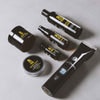Why Beard Hair is a Different Color Than Your Head Hair
Have you ever wondered why there are different colored hairs in your beard that aren’t on top of your head? A lot of guys realize that they’ve got a whole array of different colors in their beards. One of the most common stray hairs is red. It’s not an anomaly either, a majority of guys are going to find this in their beards. It is actually quite common that various parts of your hair and throughout your body are going to come with different shades and textures. The scientific reasoning behind the difference in hair describes this interesting phenomenon.
Science Behind Hair Pigmentation

Your hair color is determined by levels of pigmentation. The contributing factor comes from something called melanin. There are two distinct types that determine why one hair follicle color is different than another. The first type contains eumelanin, this constitutes brown or black shades to the hair. The other type is called pheomelanin and contributes to red and yellowish (blonde) hair colors. The difference in combinations will determine what pigment color of hair an individual follicle takes. That’s why people have so many unique varieties of hair throughout their body. There is the possibility of variance in each individual follicle. Genetics from both of your parents determines the transfer of hair color, unless you are out there dying your hair for some reason. Simply put, those with more blonde hair have a high concentration of pheomelanin and those with dark hair have a higher concentration of eumelanin.
Genetics Behind Hair Color
Our genes play a substantial role in determining our physical attributes, including the color of our hair and beard. One of the key players in this genetic game is the MC1R gene. It’s located on the melanocortin 1 receptor and influences the type of melanin our body produces, which in turn determines the color of our hair. This gene operates on a single gene on a chromosome and forms part of our hereditary traits.
Interestingly, the MC1R gene plays a significant role in deciding whether a person will have red hair or a red beard. Variations or mutations in this gene can result in an increased production of a pigment known as pheomelanin, which imparts a red or ginger hue to the hair. This explains why some individuals, even those without red hair, might sprout a ginger beard.
Why Beard Hair May Differ from Head Hair
As you read this article, you may ask yourself: “Why is my beard lighter than my hair?” Often, you will find individuals with a distinct difference between their beard hair and head hair color.
This puzzling phenomenon traces back to our genetics and the MC1R gene we've discussed before. This gene, which also influences skin color, behaves differently in different people. For some, a mutation in the MC1R gene may only affect the beard hair, leading to a different color than the hair on their head. For instance, seeing a man with brown hair sporting a red beard is not unusual.
Hair follicles for beard hair and head hair are genetically different and react differently to the hormones in our bodies. This can also lead to variations in color. Hair follicles are influenced by hormonal changes, which could potentially alter the pigment production in the hair at different parts of our body, such as the beard or the scalp.
The Curious Case of the Red Beard: Why Is My Beard Turning Red?
In some individuals, the phenomenon of differently colored beard hair is more striking. Non-redheads, or individuals with blond hair or black hair, often end up with red beards. The sight of a man with dark hair and a ginger beard or a blond-haired person with a reddish beard isn't rare.
This occurs due to the mutated MC1R gene, which, even when partially activated, produces some amount of pheomelanin, the red pigment. So, even if your hair isn't red, the follicles on your face might react to these MC1R gene variations and produce a red beard.
There’s also the possibility of coming across someone with black hair or brown hair but a blond beard, someone with brown hair and a black beard, and vice versa.
Interestingly, the recent trend on social media platforms like TikTok, where users share their unique beard and hair color combinations, has highlighted the prevalence and popularity of red beards.
Red Hair Gene
Red hair pigmentation is caused by a mutation in a gene researchers call the MC1R. If you have two of these mutated genes then you have all red hair. If you just have one of these genes then you’ll have red hair in random places in your body – including your beard. So even if you have dominant blonde hair for example, the red gene may be lurking about in your genome. This brings us to two different red beardos. Complete Ginger Beard
- Has both MC1R genes. Red hair on the head and an equal beard to match!
- Different shades of red are still possible here.
Rare Red Beard
- Contain mutated MC1R genes.
- Hair color on head does not reflect your red beard.
- Only 2% of the population have this makeup.
Often you may find that if you have some red hairs somewhere in your beard is because of both genetics and amount of pigmentation. An excess of pheomelanin can contribute to those random red hairs. Somewhere down the line in your family lineage, these genes were there and resurfaced from some distant ancestor. That is one of the reasons you find these oddly colored hair spread throughout your beard. Digging deeper to why this occurs in the first place, is another scientific question indeed. Something Darwin might have been puzzling over.
Variations Across Ethnic Groups
Ethnicity can also play a role in the color of your beard. Certain ethnic groups are more likely to carry the gene variations leading to a red beard. For instance, individuals of Irish or Dutch descent are more likely to experience this phenomenon due to a higher frequency of the MC1R gene variation in these populations.
Moreover, people with fair skin are more prone to have red hair or a red beard due to the higher presence of pheomelanin. In contrast, people of African or Asian descent are more likely to have eumelanin, which results in black hair or a black beard.
Different ethnicities also have different hair structures, which can influence the color appearance. For instance, thicker strands of hair, common in some Asian populations, can appear darker due to the way they absorb light.
Other Reasons for Variance
There are other reasons your hair changes a different color too. Without a proper care regimen and growth supplement there are times that your hair can be caused by a deficiency in vitamins. Another major culprit of different hair color, comes from right above our heads. The sun is notorious for its lighting glow that will turn your beard locks into a sun washed surfer’s wave. A lot of exposure through the sun will lighten your hair. If you’re having a lot of grey or even white hairs, it could be due to age, genetic factors or stress. Any one of these factors could contribute to that, but rocking it with pride adds to the manliness factor. No matter what color(s) shows up in your beard, make sure to keep good care of it and let it do its thing. It’s a marvelous aspect of your unique nature.
Beard Care for Different Hair Colors

Regardless of your beard's color, maintaining good beard care is crucial. Whether you have a red beard, brown beard, or black beard, the underlying principles of beard care remain the same.
Products designed specifically for beard care, like those offered by The Beard Club, can help in maintaining a healthy, lush beard. From Beard Growth Vitamin Spray that hydrates and nourishes your beard to Beard Growth Oil that keeps your beard soft and strong, good beard care products are a must for maintaining that effortless confidence that comes with a well-groomed beard.
Embrace Your Unique Beard Color
The intriguing world of genetics and pigmentation gives us the diversity of beard colors we see around us. The next time you see your reflection showing a brown-haired person with a red beard, remember: it's the uniqueness of your genes that brings out this fascinating blend. With the right beard care and an understanding of the science behind it, you can rock your unique look with bold simplicity and effortless confidence.
Sources:





